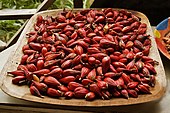Grains of paradise
| Grains of paradise Aframomum melegueta | |
|---|---|

| |
| Scientific classification | |
| Kingdom: | Plantae |
| Clade: | Tracheophytes |
| Clade: | Angiosperms |
| Clade: | Monocots |
| Clade: | Commelinids |
| Order: | Zingiberales |
| Family: | Zingiberaceae |
| Genus: | Aframomum |
| Species: | A. melegueta
|
| Binomial name | |
| Aframomum melegueta K. Schum. | |
| Synonyms | |
| |
Grains of paradise (Aframomum melegueta) is a species in the ginger family, Zingiberaceae, and closely related to cardamom. Its seeds are used as a spice (ground or whole); it imparts a pungent, black-pepper-like flavor with hints of citrus. It is also known as melegueta pepper, Guinea grains, ossame, or fom wisa, and is sometimes confused with alligator pepper. The terms African pepper and Guinea pepper have also been used, but are ambiguous as they can apply to other spices such as grains of Selim (Xylopia aethiopica).
It is native to
Characteristics
Aframomum melegueta is an
The pungent, peppery taste of the seeds is caused by aromatic ketones, such as (6)-paradol (systematic name: 1-(4-hydroxy-3-methoxyphenyl)-decan-3-one). Essential oils, which are the dominating flavor components in the closely related cardamom,[3] occur only in traces.
The stem at times can be short, and usually shows signs of scars and dropped leaves. The leaves are narrow and similar to those of bamboo, with a well-structured vascular system. The flowers of the herbaceous plant are aromatic, with an orange-colored lip and rich pinkish-orange upper part. The fruits contain numerous, small, golden red-brown seeds.

Uses

Melegueta pepper is commonly used in the cuisines of
In 1469, King
.The importance of the A. melegueta spice is shown by the designation of the area from the
The presence of the seeds in the diets of
Today the condiment is sometimes used in gourmet cuisine as a replacement for pepper, and to give unique flavor in some
Folk medicine and ritual uses
In West African
See also
- Aframomum corrorima
- List of culinary herbs and spices
- Phytotherapy
References
- ^ "Southern Nations Nationalities and People’s Region (SNNPR) Livelihood Profiles: Regional Overview" Archived 16 July 2011 at the Wayback Machine, FEWS Net (January 2005), p. 27 (accessed 18 May 2009)
- ISBN 978-0-12-809286-6, retrieved 2 March 2021
- Chaucer's "The Prioress's Tale" was grains of paradise.
- ^ Several medieval recipes are republished in Two Fifteenth-century Cookery-Books, Thomas Austin (ed,) Early English Texts Society, vol. 91 (1888) (cited in passing by Beichner 1961), under the names graynys of parise, graynis of parys, graynys of Perys, and simply graynis.
- ^ ISBN 0-8493-2332-0
- ^ "Its popularity may have been due to the brilliant name thought up for it by some advertising genius born before his times" observes Maguelonne Toussaint-Samat, Anthea Bell (tr.), The History of Food, revised ed., 2009, p. 446.
- Dioscuridesas hot and dry in its qualities, as recorded in the late 13th-century Herbal of Rufinus (Beichner, p. 305f).
- ^ "O Contrato de Fernão Gomes" (in Portuguese). Archived from the original on 3 December 2013. Retrieved 24 December 2006.
- ^ Thorn, Rob. "Discoveries After Prince Henry". Archived from the original on 11 February 2007. Retrieved 24 December 2006.
- ISBN 9788822263001.
- ^ a b Laurie's Sailing Directory for the Ethiopic or Southern Atlantic Ocean to the Rio de la Plata, Cape Horn, and the Cape of Good Hope etc., including the Islands between the two coasts; 4th ed., 1855
- ^ Kup, Peter; A History of Sierra Leone, 1400–1787 (Cambridge University)
- ^ Baynes, T. S.; Smith, W. R., eds. (1880). . Encyclopædia Britannica. Vol. 11 (9th ed.). New York: Charles Scribner's Sons.
- ^ "Gorilla diet protects heart: Grains of paradise". AskNature.org. Biomimicry Institute. 20 February 2012. Retrieved 18 April 2012.
- ^ Dybas, Cheryl Lyn; Raskin, Ilya (photographer), "Out of Africa: A Tale of Gorillas, Heart Disease ... and a Swamp Plant" Archived 1 August 2011 at the Wayback Machine, BioScience, vol. 57 (May 2007) pp. 392–397.
- ^ Brown, Alton, "Apple of My Pie", Good Eats, season 11, episode 15.
- S2CID 163651830.
- ISBN 978-1-4614-0835-2.
- ISBN 978-1-4614-0835-2.
- ISBN 978-0-9719612-1-0.
